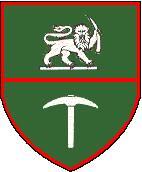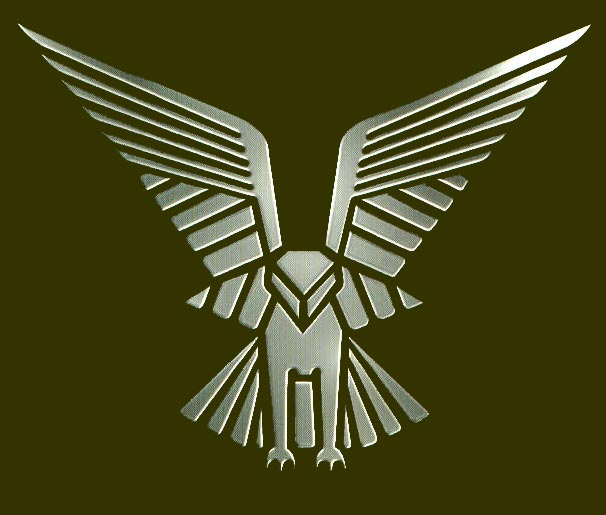|
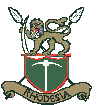
| |
Foot Patrols
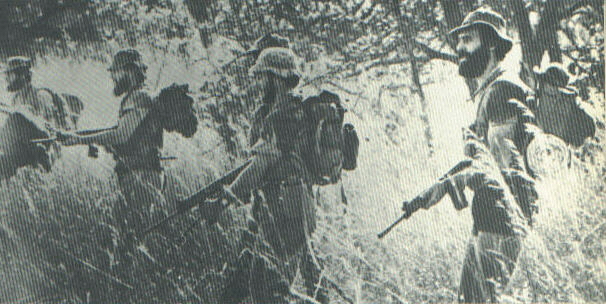
SECTION 1: GENERAL
- A common feature of rural operations is that, irrespective of whether an
operation has been planned at brigade or at troop level, or whether it has
been designed to:
- search an area of bush;
- disrupt terrorist food supplies;
- keep terrorists on the move;
- pursue a specific gang with the aid of trackers; or
- sweep progressively a large area of bush with a large number of
troops,
the troops taking part in it will almost invariably find themselves
functioning in the role of a patrol which is out of visual contact with
other troops and will have a local aim of contacting and eliminating
terrorists.
- The ability to carry out skillful patrolling, which will result in
contacting and eliminating the terrorists, is the prime requirement for all
troops engaged in rural operations. In this respect, therefore, commanders
at all levels should consider patrol planning carefully and base this on a
realistic appreciation, whether the situation be simple or complex.
Basic Aspects of Patrolling
- Characteristics. A patrol must be small enough
to move silently and yet have sufficient effective fire power. The strength
of the patrol will be determined by the size of terrorist gangs known to be
operating in the area. Patrols must almost invariably be "all
purpose" operations, prepared to fight, ambush, pursue and reconnoiter.
- Leadership and morale. Since patrolling is
frequently done by patrols of approximately platoon and section strength,
they will often be commanded by junior officers or non-commissioned
officers. These junior leaders must be well trained and their leadership
qualities developed to the full before they can command. Their leadership
must be of the highest standard to achieve the aim of the patrol, thus
instilling confidence and high morale.
- Patrol areas. Whenever possible, a patrol
commander must be given the limit and boundaries of his patrol area so that
he knows the exact area of his responsibility, thereby minimizing the risk
of patrol clashes. These boundaries must, wherever possible, follow clear
natural features; for example, ridges, rivers, roads or tracks. if this is
not possible, it is essential that all military forces are aware that
operations are taking place in the area.
- It should be made clear to patrol commanders what latitude is to be
allowed regarding boundaries in the event of a patrol encountering fresh
terrorist tracks leading out of its area.
- Whenever possible, the maximum freedom should be given to patrols to
follow up unexpected encounters rather than risk losing the chance of
engagement. In practice, it is almost impossible for a patrol in the bush to
pinpoint its position sufficiently accurately to hand over to another unit,
and in any case the delay which such a course would involve would almost
certainly result in the loss of contact with the terrorists.
- If, at the start of any operations, it is possible that a patrol may have
to cross the unit or sub-unit boundaries, clearance should be arranged
before the patrol leaves base.
- If, during an operation, a patrol needs to cross any unit or sub-unit
boundaries, clearance will be obtained.
SECTION 2: PLANNING, PREPARATION AND BRIEFING
Planning and Preparation
- Strength. The strength of the patrol depends on the following:
- The mission.
- The nature of the area to be patrolled.
- All available information about the enemy in the area.
- Attitude of the population.
- Distance to be covered.
- Duration.
- Routes and timing.
- Only in exceptional circumstances should a patrol return by its
outward route.
- "Time in" as understood in normal military patrolling must
be elastic, as speed of movement is very difficult to estimate and the
possibility of a contact makes it necessary to allow extreme latitude in
this matter.
- Security. This is an essential factor to consider when planning a patrol,
as the introduction of patrols into an operation area without the loss of
security is a major problem. Every means of avoiding observation by
civilians must be used; for example, movement by night, the use of indirect
routes and deception. Deception could include the use of civilian vehicles,
watercraft and trains.
- Casualty evacuation. The problem of casualty evacuation when troops are
committed to thick bush in remote areas must always receive prior
consideration by all concerned.
- To obtain the maximum benefit from any patrol it is essential that:
- All patrols be sent out with a clearly defined mission. In a
reconnaissance patrol this should take the form of a question or series
of questions posed to the patrol commander. Fighting patrols will have
tasks such as the search for and destruction of a party of terrorists or
the prevention of contact between terrorists and civilians in a fixed
area, e.g., in food control operations. The mission must be clearly
stated and understood by the patrol commander and his men.
- Adequate preparation and planning be made by the patrol commander. c.
The patrol is carefully and thoroughly briefed with all available
information.
- Information. The following must always be
studied and passed on to a patrol commander before his patrol is sent out:
- Topography. Full use should be made of maps, air photographs, air
reconnaissance and local knowledge. A patrol "going map"
should be kept up to date and information should be handed over to
relief patrols and passed back to superior headquarters at regular
intervals. Whenever possible the patrol commander should be given the
opportunity of prior meetings with military personnel having local
knowledge of the patrol area.
- Terrorists. Information may be available from a number of sources; for
example, captured/surrendered terrorists, air reconnaissance both visual
and photographic, captured documents, informers, etc. The past history
of terrorist activities in the area should also be studied.
- Military forces. Boundaries and movements of all military forces in
the area should be considered. If applicable, patrols should be advised
of defense-force tasks and the whereabouts of minefields, booby traps
and restricted area.
- Population. Movement and habits of the population must be studied if
movement by troops is to remain secure. The relationship between the
local population and the terrorists should be established.
SECTION 3: FORMATIONS AND MOVEMENT
Patrol Formations
- In operations so far, the patrol formation found to be most satisfactory
is the four or five group pattern with the command group centrally placed.
However, formations adopted by a patrol will vary and the patrol leader
should constantly vary the information to meet the requirements of the
terrain and the tactical situation.
- The patrol should consist of four or five groups:
- The patrol commander and his command group are positioned where
control can best be maintained at all levels. The other groups are
positioned to the front, flanks and rear. Each of the groups should be
given their areas of responsibility for observation before the patrol
moves out. In all cases the group system provides for flank and reserve
groups, with a command group centrally situated.
- Ideally each group should have a radio for control while either on the
move or to deploy tactically on a contact.
- No distances between groups are laid down as this will depend on the
terrain. They should be sufficiently far apart to prevent an ambush of
the entire patrol, but sufficiently close to be able to support each
other with fire in the event of a contact.
- With this grouping system the commander has the capability of
maneuvering part or parts of his patrol in the event of a contact,
depending on the tactics being employed by the terrorists.
- Open or close formation are used depending entirely on the condition
of the bush and ground being covered. Distances between individuals will
vary according to visibility.
- The group commanders must continually appreciate the ground and vary
the formation of their group to suit it. Similarly the patrol commander
must continuously appreciate the tactical position of the patrol. in
relation to the ground to be able to take considered immediate action in
the event of a contact. For example, there may even be occasions when
the commander prefers to keep two-thirds of his patrol strength in
reserve.
- The allocation of positions to patrol personnel within groups is not
rigid. Each commander has personal preferences, and factors of the
various types of fire support available are also flexible; circum-
stances, together with personal preferences, override any attempt to
dictate rigid drills. Leaders should therefore rehearse their own
maneuvering in the bush.
- The size of the patrol dictates the number of men in each group. As
the strength increases, so the number of men in each group can be
increased.
BASIC PATROL FORMATIONS
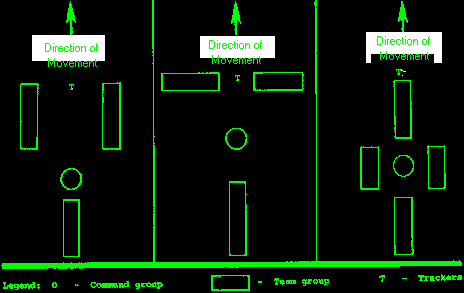
Movement of Patrols
- Silence. This is essential at all times. Control
is exercised by means of silent signals.
- Tracks and track discipline.
- Circumstances may dictate the use of tracks, but patrols must realize that by doing so, they run the risk of being ambushed.
- When moving on tracks, leaving footprints in soft or sandy patches
should be avoided.
- Stick track discipline must be enforced.
- Halts.
- When halted, positions for all-around defense must be adopted.
- The usual halt of ten minutes in the hour should be observed.
- The success of any patrol depends on good observation. Men must be taught
to observe every movement, sign of tracks, broken foliage, smoke, noise,
etc.
- Troops must be trained to disregard the general pattern of the foliage and
to look through, instead of at, the vegetation.
- Positions of patrol members.
- Commanders. The patrol commander will
normally be positioned to enable him to control his patrol and to
influence a battle by using his reserve, which he should normally
control himself. He must not become so involved in the forward elements
during contact that he cannot control the battle.
- Guides.
- The word "guide" as used here means somebody
with an intimate knowledge of an area or someone who can lead the
military forces to a known terrorist location. These may be
surrendered or captured terrorists or loyal Africans.
- The correct position for a guide is with the patrol commander. The
patrol commander will make decisions as to direction and tactics,
using the guide's advice as he wishes.
- Trackers. The tracker team is so positioned
that no trails will be obliterated by members of the patrol, but also to
allow proper link up with the follow-up patrol.
- Maintaining contact between groups.
- Although the attention of the leading elements is to the front,
responsibility for maintaining contact between groups should be from
front to rear and rear to front.
- If contact is lost, both portions of the patrol halt.
- The rear portion of the patrol casts forward trying to following the
trail of the leading element.
- Conclusion. Sound patrol formations are necessary in order that:
- Control is exercised.
- Movement is facilitated.
- The patrol is ready for immediate action.
SECTION 4: METHODS OF PATROLLING
- The troop commander, or force commander, while planning his patrol
program, must bear certain factors in mind which will help him in
arriving at the best or most effective method that he should use to
effectively patrol his allotted area. The factors that he should consider
are:
- The nature of the terrain.
- The type of patrol, i.e., fighting or reconnaissance.
- The type of operation.
- The tactics or habits of the enemy, should they be known.
- The presence and attitude of the local population. f. Standard of
training and combat efficiency of his own troops.
- Having given careful consideration to the above-mentioned factors, the
platoon or force commander has the following methods of patrolling which he
may use:
- Fan method. In this case the patrols radiate
outward from the patrol base or center point on a specific bearing for a
specific distance, all turn in the same direction at right angles to the
outward route and move for a specific distance, then turn again at right
angles in the direction of the point of origin and return to the point
of origin, i.e., patrols based on a specific bearing. This method is
very useful when searching for specific enemy signs or when conducting
search operations in very dense bush or forests. The diagram below
illustrates this method.
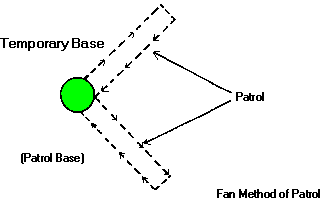
- Baseline method. In this method, patrols
operate from a baseline which could be a path, track, river or feature.
The patrols start from the baseline and all move in the same direction
on a compass bearing parallel to each other for a specific distance and
turn again at right angles in the direction of point of origin and move
back to the baseline on a compass bearing. This method is useful when endeavoring
to "cut" across possible enemy movement or tracks
or when searching fairly dense bush or forests. Distances between
patrols will be determined by the terrain. The diagram below illustrates
this method.
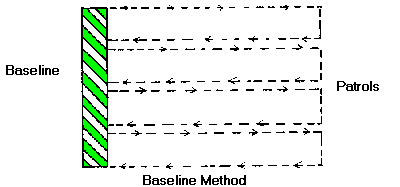
- Stream or river line method. In this method,
the patrols follow the rivers or streams in the area. On the outward
journey, the patrol moves on one side of the river/stream, and on the
return journey, covers the other side of the river/stream, thus ensuring
that both sides have been covered. The enemy, just like the military
forces, requires water and this type of patrol should discover where the
enemy's water point is or where he probably crossed the river or stream.
- Area method. This is probably the more
common method of patrolling that will be used. In this case the patrol
is given an area and boundaries and a limitation, this being the
furthest point to which it must patrol. It may also be given certain
points of interest which it must have a look at. Further, the patrol
commander is entirely responsible for planning very carefully and
selecting a route that will be the best for him to enable him to carry
out his task. He must plan to search all possible enemy hideouts, routes
followed by the enemy, possible water holes or springs in his area and
at the same time plan to avoid possible enemy ambush positions and
difficult areas to traverse such as deep ravines or cliffs. Although the
patrol commander carefully plans his route prior to commencing his
patrolling, he need not rigidly adhere to his planned route. He must be
prepared to break away from his planned route should he see or notice
something that looks interesting or suspicious some distance away. The
secret of the success of this method of patrolling is making the best
use of the terrain, i.e., contours, spurs, ridges, rivers, etc., without
unnecessarily tiring the men, and yet covering the maximum amount of
ground in the time laid down. This is a far-ranging patrol and covers a
greater distance and area than the other methods.
SECTION 5: DRILL ON RETURN
- Debriefing.
- Whatever the time of day or night, the troop commander or briefing
officer must be available to debrief the patrol commander. The commander
may require the information urgently to plan the next operation. b.
Debriefing must be thorough and reports must be clear.
- Drills for reception on return. A sound drill must be followed for the
reception of patrols on their return to base. Points to be considered are:
- A hot meal and drink should be provided.
- Weapons must be cleaned.
- A bath, if possible.
- Clean clothes, if possible.
- Rest must be arranged.
- Discussion should be held on mistakes made and lessons learned.
- Additional requirements are left to the discretion of the commander.
SECTION 6: ENCOUNTER ACTIONS
General
- Encounters with terrorists are sudden, short, and often so unexpected that
the opportunity to inflict casualties is lost. What is required is
immediate, positive and offensive action.
- For this reason it is essential for simple encounter actions to be taught
and thoroughly practiced. It is impractical to attempt to cover every
contingency by committing to paper numerous "drills," because not
only would they tend to cramp initiative but they would not be read or
digested or remembered in the stress of action. It is, however, important to
teach an action to cope with any situation commonly met. The principles
underlying the action must be simplicity, aggression, s peed and
flexibility.
- Before a patrol leaves its base, the commander in his briefing should
include directions for encounter action. This is necessary each time because
patrols vary in strength and Organization according to the nature of their
tasks. In addition, the mention of the encounter actions applicable to the
operation will act as a reminder to the troops taking part and so help them
to avoid being surprised.
- A high standard of weapons training, marksmanship and a thorough under-
standing and instinctive awareness of weapon capabilities and limitations
will ensure that encounter actions are successfully executed.
The Encounter Actions
- It is important to note that although encounter actions are usually taught
on a section basis, they can be adopted for use by a platoon. These actions
are applicable to the varied forms of terrain and in all cases normal
infantry minor tactics or section and platoon battle drills usually apply
after the initial contact. These encounter actions are a sound framework on
which leaders at all levels should build as their experience dictates. it
should be remembered, however, that no action, drill or order will achieve
success unless the leader and men have practiced them to a stage of
instinctive action, reflex and immediate reaction to firm and confident
initiative on the part of the leader.
- If a patrol is accompanied by persons who have little or no knowledge of
encounter actions, e.g., guides, informers, surrendered terrorists, etc.,
the patrol leader should keep them strictly under control and in his view.
These persons should be briefed as thoroughly as possible before the patrol
starts. It may prove as well to rehearse encounter actions for these persons
or even for inexperienced troops before a patrol moves out on operations.
- Encounters with enemy could fall under one of the following headings:
- Situation A. The initiative is with the
military forces (terrorists seen first). Reaction:
Immediate ambush.
- Situation B. The initiative is split between
the military forces and the enemy (simultaneous sighting).
Reaction: Immediate offensive action.
- Situation C. The initiative is with the
terrorist (military forces are fired on with small arms or are
ambushed). Reaction: Immediate offensive
action to an enemy ambush.
- Action for Situation A.
- This will be used for situations when terrorists are seen first by the
military forces.
- Explanation of action.
- Leading elements give silent signals.
- Depending on the cover and distance, military forces make any
reasonably silent attempt to go to ground in the best possible fire
position. Minimum movement and silence may prove vital. Fire will be
opened only on the orders of the patrol commander or in the event of
the position being detected by the enemy.
- The commander now makes a quick assessment and issues silent
signals/orders accordingly. His aim must be to eliminate as many
terrorists as possible using the closest range and the best selected
killing ground.
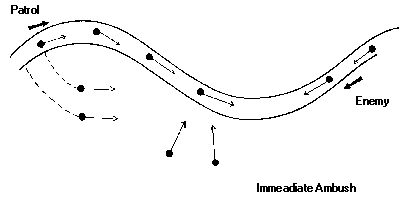
Note: The above actions are in effect a minor ambush. At troop level
it is not normally possible to deploy into a particular area. At
section level it may be possible to move everyone into specific
positions if movement is acceptable and the terrorists are approaching
along a definite route, i.e., a track, river bed or game trail.
- Action for Situation B.
- a. Immediate offensive action may be taken when military forces:
- Encounter sentries outside a terrorist base perimeter;
- Encounter part of the terrorist base perimeter;
- Encounter a moving terrorist group;
- Encounter a visible static terrorist group (in a base, at a
resting place, drawing water).
- Explanation of the action.
- Elements in contact or in close proximity put down a heavy volume
of controlled fire with the aim of winning the firefight and
eliminating terrorists. It may be possible for these elements to
execute immediate skirmishing. The maximum use of grenades and light
mortars should be made.
- Patrol commander makes a quick appreciation and plan and issues
orders for the required action.
- If an assault is to take place, the route taken for deployment and
assault depends on the ground. Consideration must be given to the
deployment of cut-off groups, possibly using the patrol reserve. The
assault plan must include covering fire.
- Throughout the preliminary stages of this action, the patrol
commander must ensure that the firefight is won and the cut-off
groups are moved into positions if at all possible.
- Normal reorganization should take p the assault i.e., face after
all-around defense, clearance/security patrols, thorough search of
the area, reporting the contact. But, if at all possible, contact
with the enemy should be maintained with immediate follow-up action.

- Action for Situation C.
- This action may be used when military forces are ambushed and in
situations where part of the military force patrol is pinned down.
Note: In the case of most situations detailed below, the military
forces will not be able to confirm, until much later in the resulting
action, the strength of the enemy.
- Explanation of the action.
- Elements under fire or in close proximity go to ground and put
down a heavy volume of controlled fire with the aim of winning the
fire-fight and eliminating terrorists. It may be possible for these
elements to execute immediate skirmishing. The maximum use of
grenades and light mortars should be made.
- Patrol commander makes a quick appreciation and plan and issues
orders for the required action.
- If an assault is to take place, the route taken for deployment and
assault depends on the ground. Consideration must be given to the
deployment of cut-off groups, possibly using the patrol reserve. The
assault plan must include covering fire.

- Throughout the preliminary stages of this action, the patrol
commander must ensure that the firefight is won and the cut-off
groups are moved into positions if at all possible.
- Normal reorganization should take place after the assault, i.e.,
all-around defense, clearance/security patrols, thorough search of
the area, reporting the contact. However, contact with the enemy
should be maintained with immediate follow-up action.
- However, where the whole patrol is pinned down, the group will have to
extricate itself by maximum fire and maneuvering. Only then can
subsequent action be taken as a result of an appreciation and plan,
which may be either offensive action, or a withdrawal, depending on the
casualties sustained and the strength of the enemy.
- When a battle is at close range, the side that opens fire and applies the
heavier and more accurate weight of fire will win. Skirmishing movement will
consolidate the firefight. The encounter actions, therefore, are normally
"Go to ground, win the firefight.
- Subsequent action is based on the commander's initiative.
- To some extent, the application of the actions explained above is affected
by a patrol formation. If the formation has a leading element of approximately one-third of the local strength and the patrol commander moves into
a position from which he can command and control any battle, the normal
principles of fire and maneuver can be successfully applied. In all cases,
the basic principles of a platoon in battle must be applied by the commander
to the circumstances of the situation.
- It is most important to emphasize that there are three main actions that
take place:
- Go to ground.
- Win the firefight.
- Concurrent with a. and b. above, the commander must quickly assess the
situation and give appropriate orders. Whenever possible, the patrol
Commander is to keep his superior headquarters fully informed about the
contact, i.e., what has happened, where it is, what the terrorists are
doing and what the military forces are intending to do.
Reorganization
- After an encounter action, reorganization should be carried out as in
normal battle drills. However, in ATOPS some actions are needed in addition
to normal reorganization procedures. The following sequence of action should
be adopted for the reorganization phase after encounter actions:
- Take up all-around defense.
- Attend to own casualties.
- Sweep and search the immediate area for terrorist casualties.
- Secure live terrorists and ensure no terrorists are feigning death.
- Submit immediate radio report on the contact.
- Trackers should carry out a 360-degree security patrol about 200-300 meters
from the scene of contact to establish three requirements:
- Secure the area from counter-attack and establish sentries.
- Find out what direction was taken by fleeing terrorists.
- Select a landing zone for helicopter requirements.
- Organize the follow-up, if required.
- Organize a sweep of the target area to look for hiding terrorists,
arms, documents,-caches, caves, etc.
- Consolidate all actions taken and plan an ambush of area after a full
appreciation.
- Report by radio all action being taken. k. During f. (above) it may be
possible to:
- Submit the initial contact report to cover the rough outline of
the contact and situation.
- Call in specialists, e.g., interrogators/interpreters.
- Evacuate casualties and resupply ammunition.
- Interrogate captured terrorists and compare numbers of bodies,
packs, sleeping places, if any, to estimate terrorists' strength.
SECTION 7: PATROL BASES
General
- It is seldom that a rural patrol can be finished in one day. Basing up, by
day or night, is therefore a part of most patrols. Provided there is a drill
for establishing and breaking a base, there should be no waste of time or
confusion.
- The bases may be patrol, troop or company bases, and the general
principles to be followed are the same. Irrespective of size, a base is a
secret camp from which patrols operate. It may be in existence for one night
or for months, depending on the size and tasks of the forces occupying it.
It is difficult to keep the presence of a base secret for any length of time
due to the normal base noises such as radios and vehicles. It must, however,
be secure against attack at all times.
Siting a Base
- Well-trained and hardened troops can make a base practically anywhere, but
obviously some places are better than others. The following are the main
factors involved in siting a base:
- Position.
- Security.
- Radio communications.
- Resupply.
- Hard standing.
- Availability of water.
- Avoidance of game tracks.
- Position. The base must be so sited that the operational task may be
carried out. No difficulty should be experienced by a patrol in leaving or
returning to base in order to accomplish its aim.
- Security.
- Deception. This should always be planned.
Some suggestions are as follows:
- The hours of darkness should, when possible, be used to cover the
approach march.
- It may sometimes be necessary to detain local inhabitants who have
blundered into patrols during the approach march.
- During the approach march, centers of population should be
avoided.
- False airdrops can be made to give the impression that troops are
present in an area where in fact there are none.
- Do not use the obvious place for a base.
- No more than one track should lead into a base. A suggested manner
in which to lay a deceptive track is to allow it to pass the base at
an angle. This would allow the occupants of a base to hear persons
approaching and so act as a warning.
- Silence. The base must be established
silently, and the use of machetes, entrenchment tools, etc., must be
kept to a minimum. On occasions, in thick bush, it may be necessary to
clear a perimeter path or internal paths to permit quick and silent
movement within the base.
- Fires. The use of cookers should be limited
as they can be smelled for some considerable distance. Fires should be
smokeless, and it is desirable that they be extinguished before last
light.
- Dress and equipment. Members of a patrol
base should not be allowed to leave items of dress and equipment lying
around, nor should they be allowed to lounge around in a state of
undress. A white towel or t-shirt, or even the whiteness of a person's
body can be seen from a considerable distance and prejudice the security
of the base. All items of clothing and equipment should be colored jungle green, khaki or black. White articles must be covered or splashed
with mud.
- Stand-to. It is essential in operations
against terrorists for all men to be alert when initially basing up and
just before first and last light. During these periods, the commander
satisfies himself that all precautions have been taken to ensure the
security of the base. (See paragraph h. below.) Additional reasons for
this stand-to procedure are:
- It enables every man to check that he knows exactly the
disposition of his neighbors to the flanks, front and rear. This is
the best safeguard against confusion should the base be attacked.
- It ensures that every man rises in the morning, retires for the
night and goes on sentry duty properly equipped and with all items
of arms, ammunition and equipment ready at hand.
- Evening stand-to may be conveniently used by the commander to
check arms, equipment and stores.
- Sub-unit commanders detail day and night sentries and can check at
stand-to that every man knows his tour of duty and his orders.
- Commanders can check that each man knows what to do in case of
alarm, and knows what troops, if any, are outside the patrol base
and their expected time of return.
- Commanders are able to ensure the strict observance of medical
precautions, and to inspect men and weapons.
- Sentries by day.
- Sentries must be posted, particularly to observe tracks leading
past or into the base.
- Their positioning should be such that a timely warning may be
given to the base on the approach of any person(s).
- Sentries should also be posted near latrines and water points when
in use.
- Sentries by night.
- Double sentries should always be posted if the patrol has
sufficient men.
- Sentries must have some means of waking their commander silently.
- Timings for sentry duty for double sentries should overlap, e.g.,
one man on from 0100 to 0300 hours and his colleague on from 0200 to
0400 hours. If there are only single sentry arrangements, the sentry
coming on duty should arrive 30 minutes early to adjust to night
vision and get accustomed to salient features in the vicinity of the
base.
- Patrols.
- Security patrols. A security patrol must
be sent out to ensure that the area surrounding the selected site
for a base camp is clear of terrorists. This patrol should go out
each day at first light and last light. Stand-to should be
maintained until the patrol returns to report the area clear or
otherwise. This patrol is vital to avoid any chance of surprise
attack by terrorists, and could pick up spoor laid during the night.
- Normal patrols. Patrolling must be
carefully controlled by the commander so that tracks in the area of
the base are kept to a minimum.
- Carrying of weapons. Every man must be armed
at all times. The reason is obvious, but only strict discipline will
ensure that this rule is observed.
- Alarm scheme.
- When firing starts, or the alarm signal is given, every man moves
silently to his stand-to position. There must be no further movement
in the base until stand-down is given. This system ensures that
anyone moving during the period of the alarm must be a terrorist and
can be dealt with accordingly. It is essential that the alarm scheme
be practiced by day and by night.
- There should be no firing at night until the terrorists are a
certain target.
- Shell scrapes should be dug whenever possible and should serve the
dual purpose of being the alarm position and sleeping position.
- Leaving a base. When leaving a base, every
effort must be made to obliterate any signs of occupation and in
particular any tell-tale marks of the time of occupation. Any shelters
should be destroyed before the base is vacated.
- Radio communications. A base must have good
facilities for radio communication. Although it would be preferable for good
communications to site a base on high ground, this will not always be
possible from a tactical point of view, and therefore the commander of a
base must compromise in the selection of his base site.
- Resupply. When operating in remote areas, the
only method of resupply may be air. Air supply, with the incumbent selection
of a dropping zone, must not be allowed to affect the tactical siting of the
base. The proximity of the dropping zone to a base is prejudicial to the
security of a base. Therefore, a long carry is preferable to forfeiting
security. An alternative is to vacate the base and move on after taking an
airdrop.
- Hard standing. The base must allow men to sleep
in comfort. Do not select an area which is wet underfoot and do not expect
to sleep comfortably on steep slopes. Flat and dry ground that drains
quickly is the best.
- Availability of water. The base should be sited
near water. Excessive movement from the base to the water-point may well
prejudice the security of the base unless there is an extremely well-covered
route. The decision as to whether to site the base close to water or some
distance away will be influenced by the local situation. Terrorists, for
example, frequently site their bases some distance away from water in order
to obtain maximum security.
- Avoiding game tracks. As these tracks are not only used by game, but may
well be utilized by terrorists, a base should not be sited across or in the
vicinity of such tracks. Should game use such a track and scent humans, they
are likely to leave the track and create a new track, so giving an
indication to the terrorists that humans are in the vicinity.
Sequence of Establishing a Base
- A suggested sequence for the establishment of a base is as follows:
- The patrol commander and escort will move to the area where he
considers he will site his base.
- When he has selected his site, he calls forward the remainder of the
patrol. The patrol, in coming forward, is to exercise caution in using
the track and route used by the patrol commander.
- When the patrol arrives, the patrol commander indicates on the ground
12 o'clock and 6 o'clock positions for the base and details positions
for each group.
- Groups, under their commanders, move into their indicated positions
according to the clock system, and make contact with the groups on their
left and right.
- At the same time the patrol commander orders stand-to and sends out
local security patrols to ensure that the area within hearing distance
is clear of stray local population and terrorists. These patrols should
circle the base about 400 meters out searching for spoor and listening
for foreign sounds.
- While the local security patrols are searching the area, the patrol
commander quickly goes around making adjustments to group positions to
ensure all-around defense is established and the men are alert.
- The patrol is to remain at stand-to until the local security patrols
return.
- On return of the local security patrols, and before stand-down, the
patrol commander holds an order group and orders are issued. The
following points may be covered:
- Sentries, passwords, stand-to, stand-down and alarm scheme.
- Base security and search patrols.
- Routing for next day.
- Maintenance of weapons.
- Water.
- Cooking, fires and smoking.
- Latrines.
- No matter how tired the men may he or what the situation, the sequence
suggested above should be followed as near as possible. Appropriate
security arrangements listed in this section should also be taken for
semi-permanent base camps.
- Should a temporary base be occupied in daylight, it may be desirable
to p first secure the area by means of patrols to minimize the chance of
enemy interference during occupation.
Administration of a Base
- If base administration is not of a high standard, patrolling from the base
will deteriorate, because living in it will be unpleasant and tiring. Some
of the points which require attention are:
- Latrines. These are normally outside the
base and will be protected by the sentry layout.
- Disposal of refuse. Refuse must be disposed
of in such a manner that scavengers (e.g., baboons, jackals, hyenas,
etc.) will not dig it up. it is suggested that a likely method of
disposal is to dig the latrine pits deep enough to accommodate excreta
and refuse. This will usually deter wild animals and scavengers from
digging up the pits.
- Tins. All tins should be punctured before
burial so as to render them useless.
- Water purification. The patrol commander is
responsible for ensuring that all water is sterilized before use.
- Cooking. Arrangements for cooking will
depend on the situation and the instructions of the patrol commander.
Experience has shown that cooking in pairs has many advantages. However,
this is not the only method and depending on the situation it may even
be necessary to cook away from the base and then bring the food to the
base for consumption. Alternatively, the situation may permit centralized
cooking in the base.
- Duties. Under normal conditions, when a
patrol of platoon strength is committed for a long period, it has been
found that two section patrols deployed and one in base is the most
efficient method of rotating duties. The sections rotate on a daily
basis with the one in base responsible for the security of the base and
fatigues.
Conclusion
- A patrol commander must appreciate not only the importance of establishing
a base, but also of establishing an efficient one, whether it be a framework
deployment base or a semi-permanent base. An efficient base is one in which:
- The security arrangements are sound and known to all.
- Duties are evenly distributed and rest is organized.
- Strict hygiene rules and water discipline are laid down and observed.
- A high all-around standard of discipline and routine is maintained.
SECTION 8: POACHING PROCEDURE IN FRIENDLY FORCES AREA
General
- During operations, there will be occasions when a patrol following up a
terrorist party, e.g., after a contact or by tracking, reaches the limit of
its boundary and wishes to continue the follow-up in another unit's or
sub-unit's area.
- 61. To avoid delay in the follow-up, quick clearance for a patrol to
operate in another unit's area is necessary.
Principles
- When clearance is required, the following principles will be observed as
far as possible:
- Within a battalion. Should a company request
clearance to operate in the area of another' company of the same
battalion, authority to do so may be given by battalion headquarters.
Battalion headquarters must inform the second company of the extent of
the clearance, and that company must in turn inform the platoon(s)
involved.
- Inter-battalion. When a battalion wishes to
operate in another battalion's area, prior clearance from the second
battalion must be obtained, either direct or through formation
headquarters. If clearance is obtained direct, the formation
headquarters must be advised as soon as possible.
- Inter-formation. Under no circumstances will
a patrol cross into the area of another formation without the authority
of that formation. Clearance in these cases will be obtained at
formation level.
- Boundaries. Whenever clearance is granted,
the cleared area will be bounded by easily recognizable natural
features. Grid lines will not be used to define a cleared area.
Emergency Poaching
- In an emergency, when communications are impossible, a patrol commander
must decide whether the target is worth the risk of a clash with the
military's own forces. Should he decide to cross, it is incumbent upon him
to ensure that:
- Any terrorists seen are positively identified as such before fire is
opened.
- He is confident that he can identify himself to any friendly forces
encountered before fire is opened by them.
- When entry into another unit or sub-unit's area has been made, full
particulars of the reason for and extent of the entry will be given to the
appropriate headquarters as soon as possible.
SECTION 9: PATROL ORDERS AIDE MEMOIRE
- Situation
- Terrain.
- Any information about ground.
- Use of maps, air photos, visual reconnaissance and patrol
"going" maps.
- Enemy.
- Strength.
- Weapons and dress.
- Known or likely locations, activities, habits and background.
- Threat and capabilities.
- Population.
- Attitude towards own troops and enemy.
- Relationship with the enemy.
- Daily routine.
- Traditional authorities.
- Own forces.
- Activities of other patrols.
- Air and artillery tasks, if any.
- Fire support available.
- Mission. The mission must be specific and clearly defined. It takes the
following forms:
- Reconnaissance patrol -- question.
- Fighting patrol -- definite aim.
- Execution
- Strength and composition of patrol.
- Individual tasks.
- Time of leaving and anticipated time of return.
- Routes out and in. If helicopters are to be used, location of landing
points.
- Specific area of interest.
- Boundaries.
- Probable bounds and rendezvous.
- Formations.
- Fire discipline.
- Deception and cover plan.
- Authority to enter another unit's or sub-unit's area of
responsibility.
- Action to be taken on meeting terrorists.
- Action to be taken on meeting local population.
- Action if ambushed.
- Action if lost.
- Do not:
- Move in file in open country.
- Move through defiles.
- Return by the same route as that used for outward move.
- Relax because you are nearing base.
- Security measures during halts.
- Administration and Logistics
- Rations and water.
- Type and number of days to be carried.
- Cooking and eating arrangements.
- Water discipline and quantity.
- Equipment and dress.
- Change of clothing, if required.
- Large or small pack.
- Important items such as maps, compasses, binoculars and air
photos.
- Footwear.
- Poncho capes.
- Torches, etc.
- Weapons.
- Type.
- Proportion and distribution.
- Ammunition.
- Type and distribution.
- Signal cartridges.
- Explosives and booby traps.
- Illuminating aids.
- Medical.
- a. Medical arrangements.
- First field dressing and first-aid kits.
- Medical orderly and haversack.
- Water-sterilizing tablets.
- Salt tablets. Han,
- Anti-malaria prophylactics.
- Snakebite outfits. 102
- Insect repellent.
- Foot power.
- Use of medicines.
- Casualty evacuation arrangements.
- Friendly forces -- wounded/killed.
- Enemy -- wounded/killed.
- Special equipment.
- Camera.
- Fingerprint outfits.
- Electronic direction-finding equipment.
- etc
- Inspect all equipment and men (avoid rattles and coughs).
- Prisoners. Handling of enemy captives.
- Resupply.
- Preplanned.
- Emergency.
- Command and Signals
- General instructions.
- Radio net and frequencies (including air).
- Schedules.
- Special instructions.
- Codes.
- Net identification signs.
- Codes.
- Passwords.
- Authentication tables.
- Check and test sets.
- Antennae.
- CW keys.
- Spare batteries.
- Ground/air communications.
- DZ panels and DZ letter
- Ground/air signal code.
- Steel mirrors/ lamps.
- Location of commander and second in command.
- Final check. Check thoroughly that all points have been understood by
patrol members.
- Hand Signals
These signals are in addition to the normal conventional signals, that
is, advance, halt, close in, turn around, run, etc.:
- Enemy seen or suspected. Thumb pointed towards the ground from a
clenched fist.
- No enemy in sight (or All clear). Thumb pointed upwards from a
clenched fist.
- Light machine-gun group. Clenched fist.
- Rifle group. Two fingers pointed upwards.
- Section commander. Two fingers held against arm.
- Platoon commander. Two fingers held on shoulder.
- You. Point at man concerned.
- Me. Indicate at own chest.
- Give covering fire. Weapon brought into the aim, indicating direction.
Be prepared to give covering fire, if necessary.
- Track junction. Arms crossed.
- House, hut or building. Hand formed into an inverted "V'
indicating the shape of roof.
- Reconnaissance. Hands held up to the eyes as if using binoculars.
- Attack. Clenched fist swung vigorously over shoulder and point to
direction attack is required.
- Immediate ambush. Open hand placed over the face followed by pointing
to the ambush position.
- Reconnaissance group. Clenched fist with forefinger upright.
- Water (river, stream, etc.). Give the sign for waves with the hand.
SECTION 10: PATROL DEBRIEFING PRO-FORMA
- General.
- Area.
- Aim.
- Strength and composition.
- Duration (with times and dates).
- Routes followed.
- Terrain.
- Was the information accurate? if not, what inaccuracies were
discovered?
- Was the map accurate? If not, what were the inaccuracies?
- If air photos were used, were they helpful?
- What was the condition of the tracks followed?
- Did the tracks show signs of recent use?
- Where rivers were crossed, or followed, were there:
- Any bridges (including type)?
- Fords?
- Any recent tracks near crossing places?
- Crops and cultivation -- old and new?
- Population. If any local inhabitants were contacted outside their normal
areas:
- What was their physical condition?
- Were they friendly?
- Why were they in that area?
- Tribal affiliation?
- What information did they provide?
- Influence of political groups?
- Influence of chiefs/village headmen?
- Influence of spirit mediums?
- Hides or camps found.
- Grid reference?
- Was it occupied? If so, by how many? If not, how long evacuated?
- Number of huts/shelters and estimated number of occupants?
- Installations of a temporary or permanent nature?
- Any sentry posts? If so, how were they sited?
- Any warning signals or booby traps?
- Details of entry and exit tracks.
- Any food dumps in or near the camp?
- Any arms or ammunition found? If so, what condition and quantity?
- Were there any radio or press facilities?
- Any documents found? If so,
- Where were they found?
- Has the place of finding been indicated on each document?
- Where are they now?
- Any indication of direction taken by terrorists when leaving the camp?
- Contacts.
- Where was contact made?
- How many were there and of what race?
- How were they dressed? If in uniform, give details.
- Details and condition of arms.
- Estimate of quantity of ammunition.
- Indication of condition of ammunition. e g. Indication which could
lead to the identification of the leader.
-
- How were the orders given and how was liaison maintained?
- What formation did they adopt in:
- Attack?
- Defense?
- Snipers?
- Any automatic weapons or weapons manned by a team?
- Did they appear healthy?
- What was their morale like?
- Was language spoken identified?
- Did they use any system of signals (including radio)?
- Any casualties:
- Own troops?
- Enemy?
- Any captured enemy?
- Any surrendered enemy?
- Have the enemy dead been identified? If not:
- Were photographs taken?
- Were there any recognizable identification marks?
- When engagement was broken off:
- In which direction did the enemy disappear?
- Did they use known tracks?
- Where were you when the enemy's tracks could no longer be
followed?
- Comments.
|
